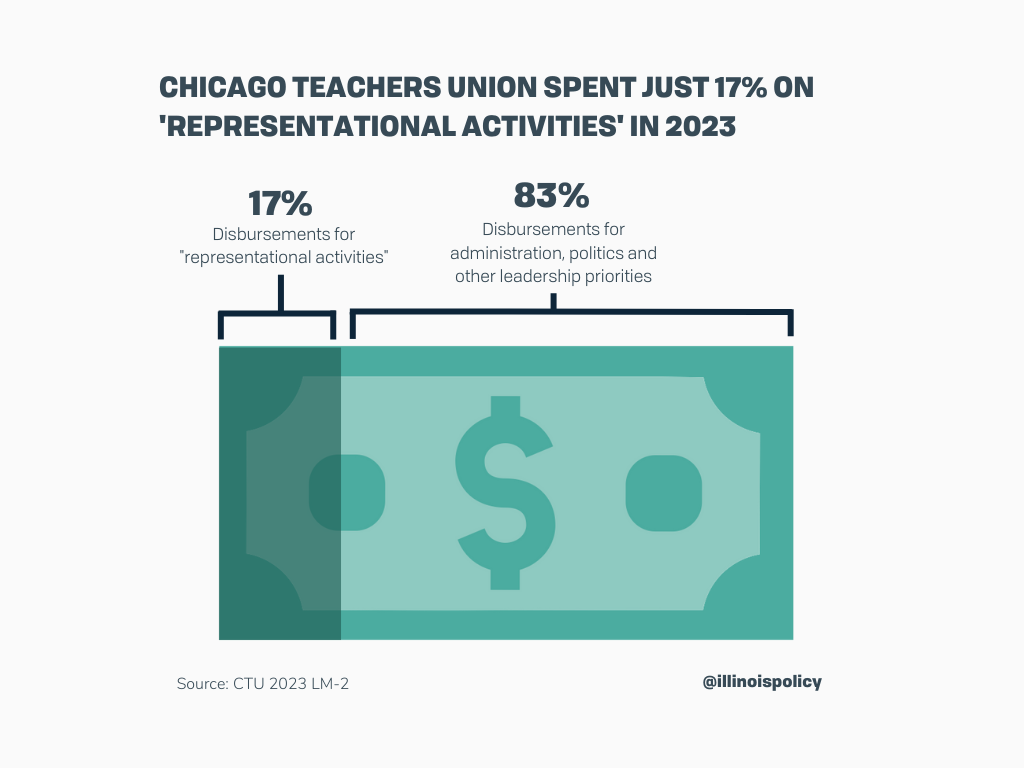Chicago Teachers Union spending on teachers down, politics up in 2023
The Chicago Teachers Union’s most recent federal report reveals just 17% of its spending in 2023 was on representing teachers, but it tripled its political spending from the previous year. Nearly 500 teachers left the union.
How a government union spends its money is a good indicator of its priorities, so for the Chicago Teachers Union it’s clear the priority is politics over supporting teachers.
That may be why it lost so many members last year.
Each year, the union must file a report with the U.S. Department of Labor, detailing its receipts and spending during the previous fiscal year. CTU filed its FY 2023 report, called an LM-2, on Sept. 25, and its own numbers reveal the following:
- Just 17% of CTU’s spending in 2023 was on representing teachers
- Less than $124 of each teacher’s dues goes back toward representing teachers
- CTU nearly tripled what it spent on politics in 2023 versus 2022
- CTU spent more than it received in 2023
- Nearly 500 education employees chose not to affiliate with the union in 2023
The report comes on the heels of other CTU controversies, which have already marred the tenure of CTU President Stacy Davis Gates.
Just 17% of CTU’s spending in 2023 was on representing teachers
Representing members is supposed to be a union’s core purpose, but just 17% of the Chicago Teachers Union’s spending in 2023 was on “representational activities.” The rest was spent on administration, politics and other union leadership priorities.

Specifically, CTU reported spending a total of $35,996,684 in 2023. Of that, just $6,223,845 was on “representational activities,” which the Department of Labor defines as those activities “associated with preparation for, and participation in, the negotiation of collective bargaining agreements and the administration and enforcement of the agreements.”
To place this in perspective, the Wise Giving Alliance, a project of the Better Business Bureau, maintains at least 65% of a nonprofit’s total expenses should be on program activities.
While the Wise Giving Alliance tracks spending by charities, it stands to reason CTU’s spending of just 17% on representation – the purpose of a union – should be a cause for concern among members.
This failure of CTU to prioritize teachers isn’t new, but it is getting worse. Representational spending in 2023 was a smaller percentage of CTU’s total spending than in any preceding year in which the union was required to file a report.
Less than $124 of each teacher’s dues goes back toward representing teachers
CTU members pay at least $1,242 a year in dues for representation.
Only $727 of that amount stays with CTU. The rest is passed up the chain to Illinois Federation of Teachers, the American Federation of Teachers or other union entities.
That means less than $124 – or 17% of what stays local – of each member’s annual dues is spent on representing Chicago teachers.
Neither IFT nor AFT prioritize representing members, either. In 2022, just 26% of IFT’s spending was on representation, according to its LM-2. AFT didn’t do much better, with just 34% of its spending on representing teachers. Those entities have not yet filed their LM-2s for 2023.
CTU nearly tripled what it spent on politics in 2023 versus 2022
Politics was a focus – and a lightning rod – for CTU in 2023.
The union nearly tripled what it spent on “political activities and lobbying,” from just over $1 million in 2022 to over $3 million in 2023. In fact, it spent more in 2023 than it did in any year since it started reporting to the Department of Labor.
This shift toward pouring money into politics was purposeful. CTU funneled nearly $2.3 million to its lobbyist and employee, Brandon Johnson, to fund his successful campaign to become Chicago mayor.
While purposeful, it wasn’t well-received by many members. At least a portion of that money came from member dues without consulting the members themselves. After an initial outcry from members who felt the union acted without their consent, CTU passed a resolution to apportion $8 a month from each member’s dues as individual contributions to the union’s political action committee, up to $2 million.
The 2023 LM-2 shows at least some of those transactions. The union’s largest itemized disbursements for politics were a $1.5 million and $500,000 transfer from the union to its political action committee for the purpose of a “municipal election.” The report also shows the union “loaned” its PAC $415,000 and has yet to be repaid for the full amount, with over $122,000 still outstanding.
CTU’s actions leading up to the election upset many members and led to the filing of an unfair labor practice against the union.
CTU spent more than it received in in 2023
For the first time since CTU started filing reports with the U.S. Department of Labor, the union reported spending more than it received in 2023.
CTU reported receipts of $35,506,529, including $30,254,196 in member dues and agency fees.
But it spent nearly a half million dollars more than that, reporting $35,996,684 in disbursements.

The union’s 2023 LM-2 confirms many members’ fears the union is running a budget deficit. The union has failed to provide its audits to members for at least four years, according to a CTU member who requested the audits in a private Facebook group for CTU members.
Rather than committing to provide the information, CTU’s Davis Gates attacked the member in the comment section, claiming that asking for an audit mandated by the CTU Constitution is a “dog whistle.”
Nearly 500 education employees chose not to affiliate with the union in 2023
At least 489 teachers dropped their affiliation with the CTU in 2023 compared to 2022.
In 2022, the union reported 28,342 members and agency fee payers. In 2023, that number was down to 27,853.
The drop is not surprising, given teachers’ frustration with CTU in recent years. In 2022, CTU’s current leadership faced an election challenge from the Members First caucus, which pledged to be different than the current leaders. The caucus claimed CTU leaders were “far more focused on advancing their own political careers than delivering” for teachers.
The numbers in the union’s most recent LM-2 don’t tell the whole story. The LM-2 covers only July 1, 2022, through June 20, 2023, but CTU only allows members to opt out of the union and stop paying dues in August of each year. That means the current LM-2 numbers don’t include anyone who opted out in August 2023 after the union’s Johnson campaign debacle.
Any teachers who left following the union’s mishandling of funds won’t be evident until the union files its 2024 LM-2 in fall 2024.
CTU members have other options
Chicago educators who want more control over their dues have options:
- Teachers can get liability insurance and legal protection elsewhere. Educators can join other associations, such as the Association of American Educators. AAE, which has 29,000 members across the country, provides liability insurance and legal protection to public school employees – at a fraction of the cost of union membership.
- Teachers can opt out of union membership and keep all employer-provided benefits. By opting out of union membership, a teacher stops paying dues to the union yet retains all benefits that are provided in the collective bargaining agreement with the school district.
Unfortunately, CTU only provides an annual window of time in which members can opt out and have their dues stopped. That window is in August of each year, but teachers interested in opting out can visit LeaveCTU.com for more information and to sign up for a reminder to opt out when August 2024 approaches.
